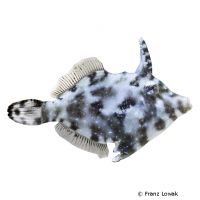Bristletail Filefish (Acreichthys tomentosus)
| Bristletail Filefish Acreichthys tomentosus | |
|---|---|
| Name | Bristletail Filefish |
| Name Lat. | Acreichthys tomentosus |
| Family | Filefishes |
| Family lat. | Monacanthidae |
| Order | Puffers & Filefishes |
| Order lat. | Tetraodontiformes |
| Origin | Indo-West Pacific |
| Habitat | Coral reefs, seagrass beds |
| Diet | Omnivore |
| pH | 8.1-8.4 |
| Hardness | 8-10 °KH |
| Behavior | Peaceful |
| Keeping | Individual |
| Reef Compatible | With caution |
| Care Level | Moderate |
| Life Span | 4-6 years |
| Protection | No |
| Metric Units | |
| Size | 10 cm |
| Temperature | 24-28 °C |
| Salinity | 33-36 ‰ |
| Aquarium | ~ 350 l |
| US Units | |
| Size | 4" |
| Temperature | 75-82 °F |
| Salinity | 1.020-1.025 sg |
| Aquarium | ~ 90 gal |
Distribution and habitat
Acreichthys tomentosus are widely distributed from the coast of East Africa through Indonesia and Australia to Japan. They live mainly in the shallow water of coral reefs between seagrass- seaweed or algae stands in 2-15 m water depth.
Maintenance
They require a calm, well-structured aquarium with a reef structure (overhangs, hiding places and retreats) with live stones that act like a biological filter, as well as sufficient swimming space and fine-grained sand areas. A dense algae population (Caulerpa) is ideal. Only lime-rich, heavy metal-free sands, gravels, stones or sea sand may be used.
Filters, skimmers and heaters are necessary to ensure water quality, as well as pumps to simulate tides, swells and bottom currents. Lighting must be appropriate for the species' day-night rhythm
| Salinity: 33-36 ‰ | pH value: 8.1-8.4 |
| Carbonate hardness: 8-10 °KH | Nitrate content: 2-8 mg/l |
| phosphate content: 0.01-0.1 mg/l | nitrite content: 0.0-0.05 mg/l |
For salinity, an average value should be aimed for, which may only vary slightly by +/- 0.5 ‰. Ammonia and ammonium must not be measurable. Special attention must be paid to constantly good water quality.
Diet
In the wild they feed mainly on small invertebrates, seaweed and sea grasses. The feed change usually succeeds without problems. The food supply should consist of a commercially available vitamin-enriched frozen food mix or a combination of chopped shrimp, squid and mussel meat with live and frozen foods such as mysis, krill and Artemia. In addition, they require plant food, such as caulerpa and algae (e.g., norialgae). Dry food is also accepted occasionally. It is recommended to feed small portions several times a day (3-5 times)
Regular and varied feeding promotes health and increases resistance.
Behaviour and compatibility
They are shy fish that are intraspecific incompatible. A harem, a male with 4-6 females can only be maintained in a much larger and richly structured tank. They can be well socialized with other calm fish.
Sex dimorphism
The sexes can be distinguished by the shape of the ventral lobe, which is larger and distinctly serrated in the adult male. Also the 1st dorsal fin hard ray is more serrated.
Reproduction and breeding
The breeding has already succeeded several times.
Important
They are well suited to control unwanted glass lice (Aiptasia). Due to their natural feeding habits, there is a risk that they will also eat large polyp corals (Trachyphyllia) and tubeworms
When socialized with other fish, they often suffer from food competition as they are slow eaters
If different species are kept together, care should be taken to ensure that the fish match each other in terms of water quality and temperature requirements and social behavior, and that the setup meets the needs of all species kept together.
Further literature can be found in your pet store.
References
Text: Werner Winter; Image: Franz Lowak
Source: KUITER, DEBELIUS (2007): Atlas der Meeresfische: Die Fische an den Küsten der Weltmeere, Kosmos Verlag; PATZNER & MOOSLEITNER (1999): Meerwasser Atlas Bd. 6, Mergus Verlag; ENGELMANN (2005): Zootierhaltung - Tiere in menschlicher Obhut: Fische, Verlag Harri Deutsch
- Gemäß § 21 Abs. 5 Tierschutzgesetz idgF
